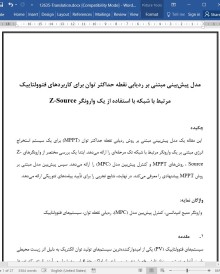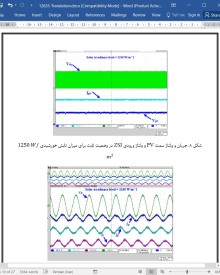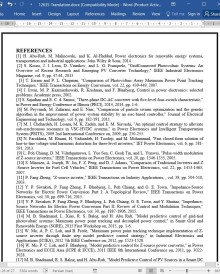
دانلود مقاله مدل پیش بینی مبتنی بر ردیابی نقطه حداکثر توان برای کاربردهای فتوولتاییک مرتبط با شبکه
چکیده
این مقاله یک مدل پیشبینی مبتنی بر روش ردیابی نقطه حداکثر توان (MPPT) برای یک سیستم استخراج انرژی مبتنی بر یک وارونگر مرتبط با شبکه تک مرحلهای را ارائه میدهد. ابتدا یک بررسی مختصر از وارونگرهای Z-Source ، روشهای MPPT و کنترل پیشبین مدل (MPC) را ارائه میدهد. سپس پیشبین مدل مبتنی بر روش MPPT پیشنهادی را معرفی میکند. در نهایت، نتایج تجربی را برای تأیید پیامدهای تئوریکی ارائه میدهد.
1. مقدمه
سیستمهای فتوولتاییک (PV) یکی از امیدوارکنندهترین سیستمهای تولید توان الکتریک به دلیل اثر زیست محیطی پایین آنها و دسترسی زیاد تابش خورشیدی در بسیاری از اماکن جغرافیایی به شمار میآیند. انرژی که توسط سیستمهای PV تولید میشود، به وضعیتهای محیطی مانند میزان تابش خورشید و دمای ماژول به شدت بستگی دارد. به منظور تضمین استخراج انرژی موجود حداکثر در هر وضعیت محیطی، MPPT برای سیستمهای PV ضروری است. بازده سیستم PV میتواند به آسانی تخریب میشود اگر ماژول PV مجبور نباشد در نقطه حداکثر توانش (MPP) در تمام زمانها صرفنظر از وضعیتهای زیست محیطی کار کند.
سیستمهای PV مرتبط با شبکه متعارف معمولاً از یک توپولوژی تبدیل توان دو مرحلهای استفاده میکند: مرحله تبدیل توان dc/dc جریان بالا از ماژول PV به یک بافر انرژی پیوند dc (مانند یک خازن) و یک مرحله تبدیل توان dc/ac جریان بالا از بافر انرژی به شبکه. تکنیکها و تحلیلهای مختلف کنترل برای هر یک از این مراحل تبدیل در منابع 4-8 توسعه داده شدهاند. شماتیک کلی یک سیستم PV مرتبط با شبکه دو مرحلهای متعارف در شکل 1 نشان داده شده است. استفاده از یک توپولوژی دو مرحلهای به دلیل محدودیت ذاتی وارونگرهای dc/ac برای بالا رفتن و پایین آمد ولتاژ بصورت آزاد ضرورت دارد. عموماً، وارونگرهای متعارف یا موجود که بصورت ورانگرهای منبع-ولتاژ (VSI) دستهبندی میشوند، فقط میتوانند ولتاژ را پایین آورند در حالی که وارونگرهای منبع-جریان (CSI) فقط میتوانند ولتاژ را بالا ببرند.
5. نتیجهگیری
این مقاله یک شمای کنترل پربازده برای یک سیستم PV متصل به شبکه ZSI را ارائه میدهد. سیستم کنترل ارائه شده دو مؤلفه دارد: پیشبین مدل مبتنی بر MPPT پیشنهادی و کنترلکننده تزریق توان سمت شبکه. نتایج تجربی THD پایین جریان سمت شبکه که در استانداردهای IEEE 519 است، پاسخ دینامیک به یک تغییر مرحلهای در میزان تابش خورشیدی و نوسانات ناچیز حول MPP تحت وضعیت آسمانی در حال تغییر از لحاظ دینامیک را نشان میدهد.
Abstract
This paper presents a model predictive based Maximum Power Point Tracking (MPPT) method for a photovoltaic energy harvesting system based on a singlestage grid-tied Z-source inverter. First it provides a brief review of Z-source inverters, MPPT methods and Model Predictive Control (MPC). Next it introduces the proposed model predictive based MPPT method. Finally, it provides experimental results to verify the theoretical outcomes.
I. INTRODUCTION
Photovoltaic (PV) systems are one of the most promising electric power generation systems due to their low environmental impact and high availability of solar irradiation in most geographical locations [1, 2]. The energy generated by the PV systems is highly dependent on the environmental and ambient conditions such as the solar irradiance level and the module temperature. In order to ensure extraction of the maximum available energy in any ambient condition, MPPT for PV systems is essential [3]. The PV system efficiency can be degraded easily if the PV module is not forced to operate at its Maximum Power Point(MPP) at all times regardless of the environmental conditions.
Conventional grid-tied PV systems typically use a two-stage power conversion topology: an upstream dc/dc power conversion stage from the PV module to a dc link energy buffer (such as a capacitor), and a downstream dc/ac power conversion stage from the energy buffer to the grid. Several control techniques and analysis have been developed in literature for each of these conversion stages [4-8]. The general schematic of a conventional two-stage grid-tied PV system is illustrated in Fig. 1. The use of a two-stage topology is necessitated due to the inherent limitation of the dc/ac inverters for stepping up/down the voltage freely. Commonly, the conventional inverters classified as Voltage-Source Inverters (VSI) can only step-down the voltage while the Current-Source Inverters (CSI) can only step-up the voltage [9, 10].
V. CONCLUSIONS
This paper presents a highly efficient control scheme for a ZSI based grid-tied PV system. The presented control system has two components: the proposed model predictive based MPPT, and the grid side power injection controller. The experimental results demonstrate low THD of the grid side current that is within the IEEE 519 standards, fast dynamic response to a step change in solar irradiance level, and negligible oscillations around MPP under dynamically changing sky condition.
چکیده
1. مقدمه
2. زمینهکاری
الف. وارونگرهای امپدانس- منبع
ب. تکنیکهای MPPT
ج. MPC برای مبدلهای الکترونیک توان
3. پیشبین مدل مبتنی بر MPPT پیشنهادی
الف. پیشبین مدل مبتنی بر MPPT سمت PV
ب. کنترل تزریق توان ZSI
4. نتایج آزمایش و بحث
5. نتیجهگیری
منابع
Abstract
.1 INTRODUCTION
.2 GROUNDWORK
A. Impedance-Source Converters
B. MPPT Techniques
C. MPC for Power Electronic Converters
.3 PROPOSED MODEL PREDICTIVE BASED MPPT
A. PV Side Model Predictive Based MPPT
B. ZSI Power Injection Control
.4 EXPERIMENTAL RESULTS AND DISCUSSION
.5 CONCLUSIONS
REFERENCES
- اصل مقاله انگلیسی با فرمت ورد (word) با قابلیت ویرایش
- ترجمه فارسی مقاله با فرمت ورد (word) با قابلیت ویرایش، بدون آرم سایت ای ترجمه
- ترجمه فارسی مقاله با فرمت pdf، بدون آرم سایت ای ترجمه



